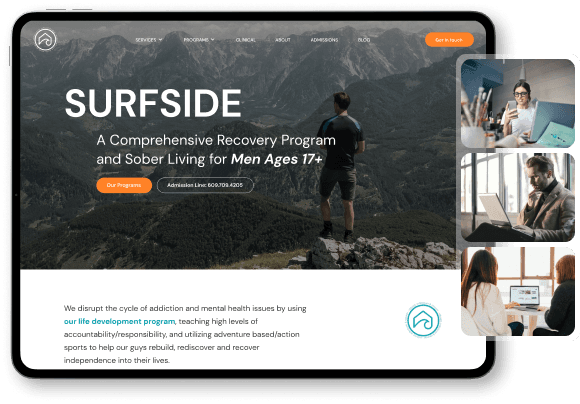blog
Complete HIPAA Compliance Guide for Mental Health Websites
May 25, 2025
Mental health professionals in the United States face unique challenges when creating an online presence. Your website isn't just a marketing tool—it's a potential gateway to protected health information (PHI) that must comply with strict HIPAA regulations. This comprehensive guide will walk you through everything you need to know about HIPAA compliant website design for mental health practices.
Why HIPAA Compliant Website Design Matters for Mental Health Professionals
The mental health industry handles some of the most sensitive patient information imaginable. A single HIPAA violation can result in fines ranging from $100 to $50,000 per incident, with total penalties reaching millions of dollars. Beyond financial consequences, privacy breaches destroy the trust that forms the foundation of effective mental health treatment.
HIPAA compliant website design isn't optional—it's essential for any mental health professional who wants to maintain an ethical practice while leveraging digital tools to reach and serve patients effectively.
The Cost of Non-Compliance
Recent statistics show that healthcare data breaches cost an average of $10.93 million per incident. For mental health practices, the stakes are even higher because:
Mental health records contain highly sensitive personal information
Patients expect absolute confidentiality in therapeutic relationships
State licensing boards may impose additional penalties for privacy violations
Malpractice insurance may not cover HIPAA-related claims
Understanding HIPAA Requirements for Mental Health Websites
What Makes a Website HIPAA Compliant?
HIPAA compliant website design goes beyond basic security measures. It requires a comprehensive approach that addresses technical, administrative, and physical safeguards. For mental health websites, this means implementing systems that protect patient information at every touchpoint.
The key components of HIPAA compliant website design include:
Secure Data Transmission: All patient information must be encrypted during transmission using industry-standard protocols like TLS 1.2 or higher.
Access Controls: Only authorized personnel can access protected health information, with role-based permissions that limit access to the minimum necessary.
Audit Trails: Complete logging of who accesses what information and when, creating accountability and enabling breach detection.
Data Encryption: Patient information must be encrypted both in transit and at rest, making it unreadable if intercepted.
HIPAA Rules That Impact Website Design
The Privacy Rule establishes how protected health information can be used and disclosed. For mental health websites, this affects everything from contact forms to patient testimonials.
The Security Rule requires specific technical, administrative, and physical safeguards for electronic PHI. This directly impacts how your mental health website is designed, hosted, and maintained.
The Breach Notification Rule mandates reporting of unsecured PHI breaches, making prevention through proper website design crucial.
Essential Features of HIPAA Compliant Website Design
1. Secure Communication Systems
Traditional contact forms and email systems aren't sufficient for HIPAA compliant website design. Mental health websites require:
Encrypted Patient Portals that allow secure communication between therapists and clients. These portals should include features like secure messaging, appointment scheduling, and document sharing.
HIPAA-Compliant Contact Forms that encrypt data before transmission and store information securely. Standard contact forms can inadvertently collect PHI, creating compliance violations.
Secure Email Integration through healthcare-specific platforms that provide end-to-end encryption and audit trails for all patient communications.
2. Advanced Security Architecture
SSL/TLS Encryption must be implemented site-wide, not just on sensitive pages. Modern HIPAA compliant website design requires HTTPS across the entire site to protect all data transmission.
Web Application Firewalls (WAF) provide an additional layer of security by filtering out malicious traffic before it reaches your website's servers.
Intrusion Detection Systems monitor for unauthorized access attempts and can automatically block suspicious activities.
Regular Security Updates ensure that your website's content management system, plugins, and security software remain protected against the latest threats.
3. User Authentication and Access Management
Multi-Factor Authentication (MFA) adds critical security for staff accessing patient information through your website's backend systems.
Session Management automatically logs users out after periods of inactivity and prevents session hijacking through secure session tokens.
Role-Based Access Controls ensure that different staff members can only access the patient information necessary for their specific job functions.
4. Data Backup and Recovery Systems
Encrypted Backups protect patient information even during storage and recovery processes. HIPAA compliant website design requires that backups receive the same level of protection as live data.
Disaster Recovery Planning ensures that patient information remains secure and accessible even during system failures or cyber attacks.
Data Retention Policies specify how long patient information will be stored and how it will be securely disposed of when no longer needed.
Technical Requirements for HIPAA Compliant Website Design
Hosting and Infrastructure Considerations
Not all web hosting providers can support HIPAA compliant website design. Mental health websites require hosting services that offer:
Business Associate Agreements (BAAs) that legally bind hosting providers to HIPAA compliance requirements.
Data Center Security including physical access controls, environmental monitoring, and 24/7 security personnel.
Geographic Data Storage within the United States to ensure patient information remains under US privacy laws.
Redundant Systems that prevent data loss and ensure continuous availability of patient information.
Database Security and Management
Database Encryption protects stored patient information using industry-standard encryption algorithms like AES-256.
Access Logging creates detailed records of all database queries and modifications, essential for HIPAA audit requirements.
Regular Security Patches keep database software updated against known vulnerabilities that could compromise patient information.
Data Minimization ensures that only necessary patient information is collected and stored, reducing compliance risks.
Content Management System (CMS) Selection
Choosing the right CMS is crucial for HIPAA compliant website design. Consider these factors:
Security Track Record: Select CMS platforms with strong security histories and regular updates.
Plugin Ecosystem: Ensure that required plugins and extensions can maintain HIPAA compliance.
User Management: Choose systems with robust user role and permission management capabilities.
Audit Capabilities: Select platforms that can generate the detailed logs required for HIPAA compliance.
Step-by-Step Implementation of HIPAA Compliant Website Design
Phase 1: Planning and Risk Assessment
Conduct a HIPAA Risk Assessment to identify all areas where your website might handle protected health information. This includes obvious areas like contact forms and less obvious ones like analytics tracking.
Document Compliance Requirements specific to your mental health practice, including state-specific regulations that may be more stringent than federal HIPAA requirements.
Develop Policies and Procedures for website management, including who can access administrative functions and how security incidents will be handled.
Phase 2: Technical Implementation
Select HIPAA-Compliant Hosting with providers who specialize in healthcare websites and can provide necessary Business Associate Agreements.
Implement Security Infrastructure including SSL certificates, firewalls, intrusion detection systems, and monitoring tools.
Configure User Access Controls with role-based permissions that limit access to patient information based on job responsibilities.
Set Up Backup and Recovery Systems with encrypted storage and regular testing to ensure data can be recovered quickly if needed.
Phase 3: Testing and Validation
Penetration Testing simulates cyber attacks to identify vulnerabilities in your HIPAA compliant website design before they can be exploited.
Compliance Auditing verifies that all HIPAA requirements have been properly implemented and documented.
Staff Training ensures that everyone who will use the website understands their HIPAA compliance responsibilities.
Incident Response Testing validates that your team can properly respond to security incidents or potential breaches.
Common HIPAA Compliance Mistakes in Mental Health Website Design
Mistake 1: Using Standard Analytics Without Proper Configuration
Google Analytics and similar tools can inadvertently collect protected health information through URL parameters, form data, or user behavior tracking. HIPAA compliant website design requires either:
Configuring analytics tools to exclude PHI collection
Using HIPAA-compliant analytics alternatives
Obtaining Business Associate Agreements with analytics providers
Mistake 2: Inadequate Third-Party Service Management
Many mental health websites use third-party services like:
Live chat widgets
Appointment scheduling tools
Payment processors
Email marketing platforms
Each service that could potentially access PHI requires a signed Business Associate Agreement and HIPAA-compliant configuration.
Mistake 3: Insufficient Staff Training
Even the most secure HIPAA compliant website design can be compromised by staff who don't understand their compliance responsibilities. Common training gaps include:
Not recognizing what constitutes protected health information
Using unsecured personal devices to access website admin areas
Sharing login credentials or failing to use strong passwords
Not reporting potential security incidents promptly
Mistake 4: Neglecting Mobile Security
With over 60% of web traffic coming from mobile devices, HIPAA compliant website design must address mobile-specific security concerns:
Responsive design that maintains security across all devices
Mobile-optimized patient portals with proper encryption
Staff mobile device policies for accessing website admin functions
Advanced Security Features for Mental Health Websites
Zero-Trust Security Architecture
Modern HIPAA compliant website design increasingly adopts zero-trust principles that assume no user or system should be trusted by default. This approach includes:
Continuous Verification of user identity and device security before granting access to patient information.
Micro-Segmentation that isolates different types of patient data and limits access to specific network segments.
Behavioral Analytics that detect unusual access patterns that might indicate compromised accounts or insider threats.
Artificial Intelligence and Machine Learning Security
Automated Threat Detection uses AI to identify potential security incidents in real-time, enabling faster response to protect patient information.
Compliance Monitoring through machine learning algorithms that continuously scan for potential HIPAA violations and alert administrators to issues.
Predictive Security that anticipates and prevents security threats before they can impact patient data.
Advanced Encryption Techniques
End-to-End Encryption ensures that patient communications remain secure from sender to recipient, with no intermediate points where data could be intercepted.
Homomorphic Encryption allows computation on encrypted data without decrypting it, enabling advanced analytics while maintaining patient privacy.
Quantum-Resistant Encryption prepares HIPAA compliant website design for future quantum computing threats that could compromise current encryption methods.
Choosing the Right Partner for HIPAA Compliant Website Design
What to Look for in a Healthcare Web Design Company
Healthcare Industry Experience is essential. General web designers may not understand the specific requirements of HIPAA compliant website design for mental health practices.
HIPAA Training and Certification of the design team ensures they understand compliance requirements and can implement them properly.
Technical Expertise in healthcare-specific technologies, security protocols, and compliance frameworks.
Ongoing Support and Maintenance because HIPAA compliance requires continuous monitoring and updates, not just initial implementation.
Questions to Ask Potential Web Design Partners
Do you specialize in HIPAA compliant website design for mental health professionals?
Can you provide references from other mental health practices?
What specific security measures do you implement for healthcare websites?
How do you handle Business Associate Agreements and ongoing compliance monitoring?
What is your process for security updates and incident response?
Red Flags to Avoid
Generic Web Design Approaches that don't account for healthcare-specific compliance requirements.
Unwillingness to Sign BAAs or provide detailed security documentation.
Lack of Ongoing Support for security updates and compliance monitoring.
Unrealistic Timelines that don't allow for proper security implementation and testing.
Maintaining HIPAA Compliance After Launch
Ongoing Security Monitoring
Regular Vulnerability Scans identify potential security weaknesses before they can be exploited by malicious actors.
Continuous Compliance Monitoring ensures that website changes don't inadvertently create HIPAA violations.
Security Incident Response procedures help quickly contain and remediate any potential breaches of patient information.
Staff Training and Education
Initial HIPAA Training for all staff who will access website administrative functions or handle patient information online.
Annual Refresher Training keeps staff updated on evolving threats and compliance requirements.
Incident-Specific Training after any security events to prevent similar occurrences in the future.
Documentation and Audit Preparation
Maintaining comprehensive documentation is essential for demonstrating HIPAA compliance:
Security policies and procedures
Staff training records
Business Associate Agreements
Security incident logs
System access audit trails
Risk assessment documentation
The Business Benefits of HIPAA Compliant Website Design
Building Patient Trust and Confidence
Patients are increasingly aware of data privacy issues and actively seek mental health providers who take security seriously. HIPAA compliant website design demonstrates your commitment to protecting patient privacy and can become a competitive advantage.
Avoiding Costly Violations and Breaches
The average healthcare data breach costs $10.93 million, making investment in HIPAA compliant website design a cost-effective insurance policy against devastating financial losses.
Improving Operational Efficiency
Well-designed HIPAA compliance systems often improve overall practice efficiency through:
Streamlined patient communication processes
Automated security monitoring that reduces manual oversight
Clear policies that reduce staff confusion and errors
Better data organization and backup systems
Enabling Digital Growth Opportunities
HIPAA compliant website design opens doors to digital growth opportunities that wouldn't be possible with non-compliant systems:
Telehealth integration for remote patient care
Patient portal features that improve engagement
Secure online scheduling and payment processing
Digital marketing campaigns that maintain compliance
Future-Proofing Your Mental Health Website
Emerging Technologies and Compliance
Artificial Intelligence applications in mental health are growing rapidly, requiring HIPAA compliant website design that can accommodate AI tools while maintaining privacy protections.
Internet of Things (IoT) devices used in mental health treatment must be properly integrated into overall compliance strategies.
Blockchain Technology may offer new opportunities for secure patient data management and consent tracking.
Evolving Regulatory Landscape
HIPAA regulations continue to evolve, with recent updates focusing on:
Enhanced cybersecurity requirements
Stricter breach notification timelines
Expanded definitions of protected health information
New requirements for emerging technologies
Stay informed about regulatory changes by subscribing to HHS Office for Civil Rights updates and working with compliance professionals who specialize in mental health practice requirements.
Conclusion: Investing in HIPAA Compliant Website Design
HIPAA compliant website design isn't just about avoiding penalties—it's about building the foundation of trust that makes effective mental health treatment possible. When patients know their most sensitive information is protected, they're more likely to seek help, engage in treatment, and refer others to your practice.
The investment in proper HIPAA compliant website design pays dividends through:
Protection from costly violations and breaches
Increased patient trust and referrals
Competitive advantage in the digital marketplace
Operational efficiency improvements
Opportunities for digital growth and innovation
For mental health professionals serious about building a successful online presence while maintaining the highest standards of patient privacy, partnering with specialists in HIPAA compliant website design isn't just smart business—it's essential for ethical practice in the digital age.
At Clear Mind Websites, we specialize in creating beautiful, functional, and fully HIPAA compliant websites for mental health professionals across the United States. Our team understands the unique challenges of mental health practice and can help you build an online presence that protects your patients, grows your practice, and maintains compliance with all federal and state regulations.
Ready to discuss your HIPAA compliant website design needs? Contact our team today to learn how we can help you create a secure, professional online presence that serves your practice and protects your patients.
Do you find this article useful?
We create beautiful websites for mental health businesses that will help families and people in need to make the right choice. Let us help you improving your website, we got the experience and the passion to convert visitors into customers.
Prev
Next



